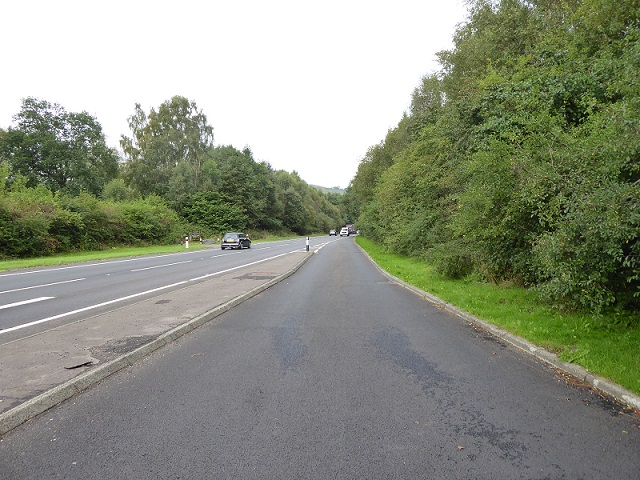
On Wednesday I drove to Luss, the first time I had been along the A82 since May, and was amazed by the transformation. Instead of the usual litter strewn verges and laybys, I had to look quite carefully to spot any litter.
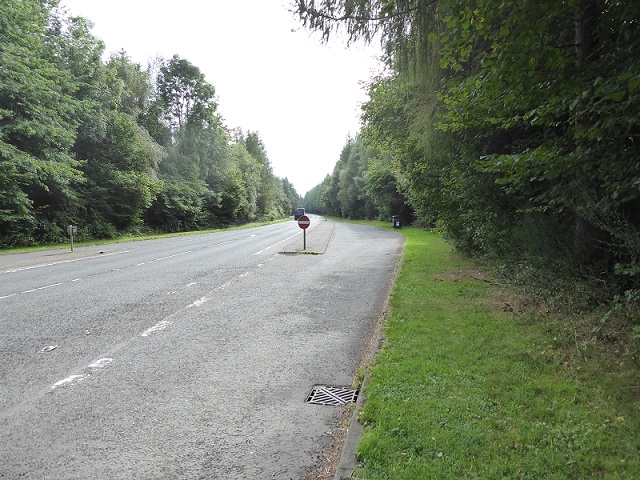
The Loch Lomond and Trossachs National Park Authority has for years had a policy of telling people to take their litter home. When it didn’t work, the Loch Lomond and Trossachs National Park Authority (LLTNPA) first blamed feckless campers for the problem and used that to justify the introduction of the camping byelaws. Then, when those byelaws didn’t solve the litter problem (see here) it started trying different tactics. Last year this included trying to shame people who leave litter:
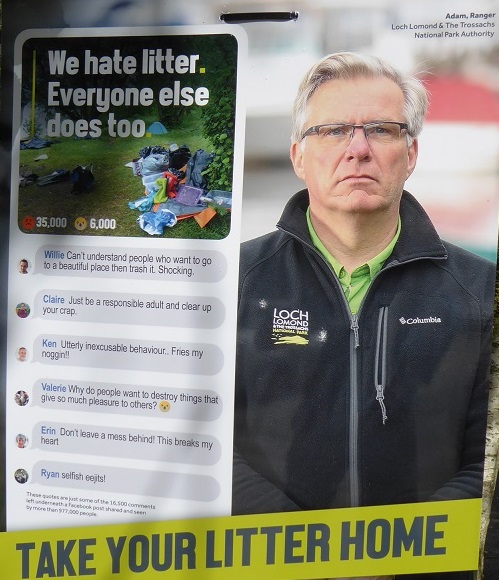
Shaming people didn’t work either, as was evidenced by the Visitor Management Review of 2020 presented to the LLTNPA Board in December 2020:
“The main visitor management issues exacerbated this season were irresponsible parking, litter and flytipping, irresponsible camping, fire damage, irresponsible toileting and high volumes of traffic in rural locations.”
Note the multiple use of the word “irresponsible”. The LLTNPA’s mindset when it comes to visitor management is blame the public whereas, as parkswatch has long argued most of the problem is due to lack of infrastructure.
In the case of litter along the A82 on Lochlomondside, Argyll and Bute Council has long refused to provide litter bins in laybys (unlike other Councils like Highland along the A9) and the LLTNPA has refused to challenge them on this. There are now litter bins in 19 laybys and guess what? Those laybys were at the time of my visit almost entirely litter free.
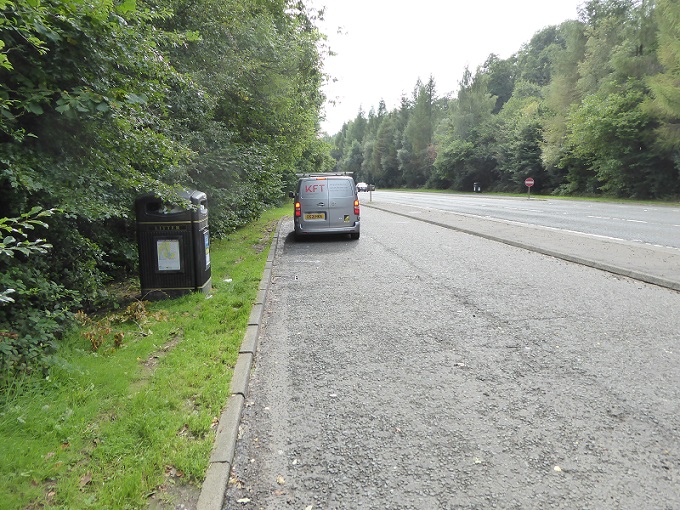
The explanation for the two bits of litter you can see by the bin above may be the result of some “irresponsible” person not bothering, but equally it could just be linked to the litter bin being full:
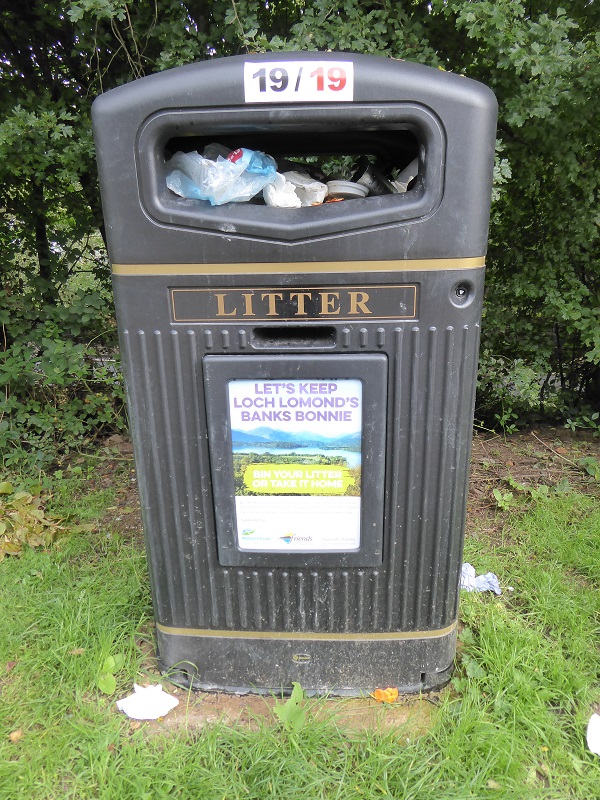
The bins are part of a pilot initiative by the Friends of Loch Lomond and Trossachs (Follat) – (I am a non-active member)- which has been mainly funded by NatureScot through something called the Green Recovery Fund. FOLLAT had in August issued a news release (see here) claiming the bins had been a success since they had been installed in late June but nevertheless I couldn’t quite believe my eyes as to the difference they have made. So I checked with FOLLAT before writing this post. They confirmed the information in their news release, that there are now people on community service doing weekly litter picks BUT the amount of litter they are finding is apparently minimal and there had been no special clean-up in the days before I visited.
There are two key points here. The first is that the pilot confirms that provision of bins is the single most effective thing public authorities can do to stop litter (in the absence of the Scottish and UK Governments failure to do anything effective to reduce packaging). The second is that if if you provide bins and keep a place litter free, the vast majority of the population will respond and stop littering.
For any parkswatch reader who has been following it, the current debate in the papers about the filthy state of Glasgow should be deja vu. In response to criticisms of the state of the urban environment, Glasgow City Council is calling its citizens irresponsible but at the same time urging them to report people who fly tip so it can take enforcement action and exhorting them to clear up their neighbourhoods themselves.
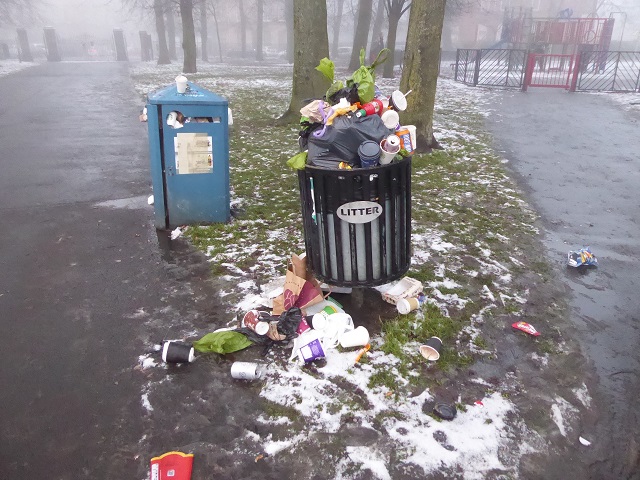
Actually, the problem in Glasgow results from reductions in refuse collection, with both household and public bins now regularly overflowing, and charges for bulk collections/use of dumps. In other words cuts, similar to those that took place in Argyll and Bute some time ago and which have had such a detrimental impact on West Loch Lomond – up until now.
Given the way that public authorities like the LLTNPA and Glasgow City Council have been trying to frame the debate – blaming their residents/visitors to cover up for their failures to provide the right infrastructure – NatureScot, whom I have had occasion to criticise on parkwatch (see here for example), deserves considerable praise for funding this pilot. In doing so, they have helped show up the LLTNPA and shown what solutions are needed.
The challenge now is to “mainsteam” these solutions . In theory, that should not be difficult. All the LLTNPA needs to do is accept the evidence and call on Argyll and Bute Council to install and maintain litter bins in every layby and other stopping off places along the A82. Their bin lorries could then empty these on their regular rounds for a significantly lower price than that paid by FOLLAT which has had to negotiate a one-off special contract with a litter disposal operator.
Unfortunately the omens are not good. In the papers for the LLTNPA Board Meeting, which took place on Monday, there was not a single mention of FOLLAT’s litter pilot, despite its success, let alone how the National Park Authority could “mainstream” the initiative. But then that would mean the LLTNPA spending money on something useful!
There was, however, a paragraph about litter, in the Chief Executive Gordon Watson’s report on the “visitor season” (a term that is used to excuse much of the infrastructure owned by the LLTNPA being shut for significant parts of the year):

Instead of celebrating the public doing the right thing at Milarrochy, a site it owns on east Loch Lomond, and considering what this says about the adequacy of its current approach to infrastructure, Mr Watson’s “however” implies that it the public filling bins to capacity is a problem. That is because he views everything as a cost and is not prepared to advocate (and collect evidence) for the resources that would be needed to make the National Park a success.
To be fair, not all is as bad as it was. Mr Watson and the rest of the LLTNPA’s senior management have, ever so slowly, as a result of criticisms and political pressure (Jackie Baillie MSP has closely associated herself with the FOLLAT project) been shifting their position. After receiving a huge handout from the Scottish Government at the start of the financial year (see here), they employed a dedicated litter team this year, albeit that the staff have been deployed mainly around the camping permit areas, which FOLLAT deliberately decided not to include in its pilot. That provides more evidence about the failure of the camping byelaws and the solutions staring the LLTNPA in the face, provide infrastructure to support all visitors.
The LLTNPA also quietly this summer (there was no news release) opened their toilets at Firkin Point, Tarbet and Inveruglas on a 24 hour basis, as I have been calling for for years. FOLLAT has kindly advertised this on the side of their bins!

The test for the LLTNPA now is whether they keep these toilets open 24 hours a day, 365 days a year, to reflect the fact that people travel and visit the National Park year round and need to go to the loo. The need for that is illustrated by one of FOLLAT’s five recommended actions in their news release:
” erecting appropriate fencing close to northbound laybys to reduce the incidence of fly tipping and outdoor toileting over wide areas”.
This point, incidentally, was picked up by the Herald and distorted out of all proportion (see here), so the story became about human waste and not about the difference bins have made.
In my view, while illustrating the reason why the LLTNPA needs to keep its toilets open 24/365, the suggestion that the north bound laybys should be fenced is misguided. First, I understand part of the issue this summer has been the smell of urine by laybys. While unpleasant, urea is non-toxic and it has probably only become noticeable because we have had such a dry summer. Second, few people want to have a crap in sight of passing vehicles and almost all would prefer to use a toilet. So what is needed is a consistent message that toilets are open along west Loch Lomond whenever you might need them, instead of constantly changing opening times. Third, whatever problem might remain after people realise toilets are open, fencing will make it worse. Instead of being able to step into the woods, people who need to go will pee against the fence, adding to the smell, and those needing a crap are likely to cross the road and go closer to the loch shore. Not what we want. And fourth, effective fencing would be a restriction of access rights: we actually need paths out of laybys to enable people to stretch their legs away from the pollution of the road.
What needs to happen?
FOLLAT’s litter bin pilot has been an obvious success. It needs to mainstreamed and litter bins installed in all the laybys and popular stopping off points in the National Park where they are currently absent. Unfortunately, the September LLTNPA Board Meeting was a missed opportunity to do that for this winter (NatureScot’s funding runs out before then) and without public pressure the LLTNPA is unlikely to do anything. So please, lobby in any way you can: the new Minister for National Parks, Lorna Slater; members of the National Park Board; local politicians and community councils if you live in the National Park; etc!
I also hope that FOLLAT will write up the evidence from the pilot into a report that the LLTNPA and politicians cannot ignore.
Parkswatch will monitor the LLTNPA’s response!
The same holds for toilets all over the Highlands, provide clean and serviceable toilets and people will use them rather than the woods. Part of opening up the countryside is to also offer facilities to all the visitors and not rely on restaurants and pubs servicing everyone who visits the area.
Excellent initiative! We need bins and toilets that are emptied/ cleaned on a regular basis available to the public 24/7/365 EVERYWHERE in Scotland/ the world: in cities, towns and the countryside. It should be a basic human provision. Well done, FOLLAT, for providing the evidence, now we need to scale it up!
Our own litter survey in Helensburgh has confirmed the same conclusion. After a summer of monitoring bins in Helensburgh and the litter in the area, Plastic Free Helensburgh confirmed that the public will use a bin that is placed in a convenient location, is easily identified as a bin and is not already full. We also need bins of a suitable design to deter gulls pulling the litter out of the bin.
In the case of a full bin thep public will stack rubbish next to the bin and are unlikely to try and find an alternative bin or take litter home. Therefore bins need to be of ample size to meet the anticipated demand of each site, a busy location near takeaway outlets or picnic areas requires more capacity.
Keep up the good work FOLLAT we agrèe with you. The public want to do the right thing, they just require the facilities.
I agree that toilets and bins are essential, but I also believe that we need to reduce the amount of single use containers and take more home for recycling.
Could it be ? could simple common sense be the answer ? Shame on LLTNPA leaders yet again. It’s now long over time for a completely new approach to the park people not puppets
Totally agree,and also dog poo bins it never ceases to amaze how much of it is around,there is so much beautiful countryside being ruined by the amount of rubbish being left everywhere
The root cause of the problem is the landfill tax which as far as I am aware was not opposed by any local authority of any political colour in any way and is the cause of all the every growing restrictions on civic amenity sites and lack of public bins.
No problem of course for the non law abiding who just fly tip and the same LA which pours resources into minutely scrutinising tip users looking for an excuse to turn them away happily clears up the fly tipping mess regularly and never does anything about stopping it bar a few obviously untrue notices about cctv.
^
Incorrect. Unfortunately it is the landowner that has to bear the bill for clearing flytipping incidents.
Yes, this is clearly unfair. The LLTNPA is now doing the right thing with its litter team that do pick up litter on private land but Public Authority responsibility for this should extend across the National Park and the rest of Scotland.
In many cases the landowner is the local authority. The fact that their name is on the worthless signs is the clue.
Agreed they are quite happy to lean on the private landowner where applicable despite the fact that it is their implementation of government policy that has caused the problem.
I know of a particularly idiotic one where a rural lane was actually closed and gated off because of the amount of flytipping on the verges. Result – gates forced open and the creation of a linear tip.
A decent article but as usual missing out on the inconvenient facts. Waste uplift comes with high costs – manpower, vehicles etc and landfill tax. The budgets of local authorities will reduce again next year. Also, local authorities will be forced to reduce waste going to landfill – 5 percent of all waste by 2025 I think.
I think the area should be revisited next year to see waste after a hot bank holiday.
One of the reasons why waste uplift costs is so high is because of the market in waste collection. Different operators all travelling the same route. Its expensive and terrible for the planet. That is well illustrated by the A82. FOLLAT has had to engage a different to Argyll and Bute Council when Argyll and Bute Council lorries drive along the road anyway to empty domestic bins. The additional cost of them pulling into laybys and emptying bins, as other rural authorities do in Scotland, would be minimal. The landfill tax has not worked. First it was directed at the wrong end of the problem, what should be taxed (or better still banned) are items that cannot be recycled. Landfill tax doesn’t hit the people who produce the stuff going to landfill so they keep churning it out; it also causes flytipping as, faced with the cost of disposing of waste, many people and businesses can’t afford to pay the tax even if they wanted to. What is even more unfair is that, having created a system that allows enormous amounts of waste and encourages flytipping, individual landowners (see comment from S) are faced with picking up the bill, not just for picking up the waste but disposing it.
Soon after the tax was introduced I heard one of its architects being interviewed on the radio. The interviewer asked him what was to be done about the resulting increase in flytipping. His reply; “Our research showed that wouldn’t happen”. When the interviewer stated that it was happening he simply repeated the statement and refused to acknowledge that reality differed from his theoretical worldview.